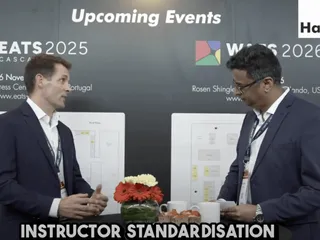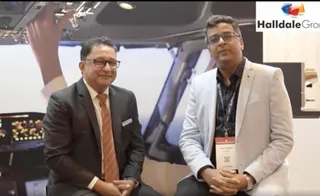Former Air Force Acquisition Chief Discusses Digital Transformation
Contact Our Team
For more information about how Halldale can add value to your marketing and promotional campaigns or to discuss event exhibitor and sponsorship opportunities, contact our team to find out more
The Americas -
holly.foster@halldale.com
Rest of World -
jeremy@halldale.com

Dr. Will Roper, former Air Force acquisition chief and CEO of Istari, delivered the first keynote address during the recent Florida Simulation Summit in Orlando, Florida, on 10 May 2023. Here are some of the highlights.
Roper first set the context for his journey in digital transformation by describing his experience working for Ash Carter, former secretary of defense. Roper said that over 10 years ago, Carter foresaw a need to build complicated weapons systems due to a rise in great-power competition, particularly with China, and he brought Roper on board to build advanced prototypes.
“I cut my teeth working on advanced systems, and the cornerstone for six years of my life was aggressively using models and simulations to de-risk… so that I didn’t have to encounter [risks] in the real world where they were much more expensive,” Roper said. “It was a way of learning faster. The lesson I took, was that models and simulations need to be a bedrock of de-risking programs, so when you build something and test it, there’s something you’ll learn that you wouldn’t have learned otherwise.”
“Never did I think that I would be able to skip the physical tests, the physical prototyping, the physical dropping, the physical data collection,” Roper said. “I thought of modeling and simulation as a springboard to get me to those [physical] tests faster. It was an accelerant.”
“In that early phase of my career, if you’d said, “There’s this thing called digital transformation and it’s going to revolutionize industry,’ I’d have told you that we already do digital transformation,” Roper said. “This isn’t a new idea… computer-aided design has been around since the 60s, model-based systems engineering has been around since the 90s. What’s changed is how well we can do this – and it's been driven by the modeling and simulation industry.”
Roper said he experienced a significant paradigm shift when he met with a McLaren Automotive team in the UK.
“They showed me how they engineered race cars, and it was like walking into a science fiction movie – it was amazing,” Roper said. “They were building over 1000 digital twins for every race. [For McLaren] modeling and simulation wasn’t used as representations, de-risking steps, or learning tools – they were the race car, period.”
Roper emphasized that McLaren’s ethos had flipped, and “they weren’t going toward the physical, they were going toward the digital.” While the racing would take place in the real, physical world, the cars were “real” in that McLaren treated the results as if they’d happened on a race day. Roper said McLaren had the data to support their conclusions, and their drivers’ training was based on those conclusions.
Having learned those lessons from McLaren, Roper went back to the Air Force and said that the same playbook worked for Air Force projects. The T-7 “fighter-like” airplane program built its prototype in three years (due to digital transformation), which according to Roper, hasn’t happened since 1958. He said the same approach was successful with other Air Force focuses, like the Sentinel missile program that created over six billion digital twins, and a B-52 project used digital twins to put commercial engines on the aircraft. He went on to explain that treating digital deliverables as real also improved aircraft upkeep through predictive maintenance and using digital representations of failure modes, which led to better choices on parts, saved money, and improved readiness.
Upon moving to the private sector, Roper noticed that digital transformation has been driven by big companies, but start-up companies are not as present as they would be in areas like artificial intelligence (AI). He said this observation led him to the realization that someone in the field should be working on the “connective tissue” that might eventually result in an “easy button.”
“The Internet of Things should evolve [to] include physics, engineering and manufacturing, [among other things],” Roper said. “The idea is to bring all the models and simulations that we currently use to make amazing things in industry and create a way to connect them to the internet so we can get internet-like functions, applications and AI. If we can bring models and simulations into the internet, the same thing should be true for hardware in the future.”
According to Roper, pulling in data from models and simulations will eventually be as common as data from “things” to the point that people don’t say “Internet of Things” anymore. When the ability to do digital transformation commoditizes and democratizes, he predicts the phrase “digital twin” will also fall out of use because users will assume everything has a digital twin.
“It’s an exciting time to be in modeling and simulation because I think this industry will become a trillion-dollar industry that’s connected to every other industry,” Roper said. “Once you’ve got these connected digital ecosystems that can model reality nearly realistically, that’s exactly what you need to train AI to do things in the physical world, and there’s some pretty cool examples of this happening.”
Roper ended his talk by discussing how AI will impact digital transformation by describing developments like the Air Force training an AI to operate a U-2 spy plane and an F-16 jet fighter through high-fidelity models and simulations. He also detailed how New Zealand’s America’s Cup sailing team taught an AI to sail. Eventually, that AI designed new boats and then trained humans how to sail differently to operate the new boats it created.
“AI has now crawled out of the internet and dominated a physical thing better than people ever will – expect that in more industries,” Roper said. “AI will lead the Internet of Things as we connect models and simulations to it, which will give it access to ‘physical’ results and learn to operate in the physical universe. New Zealand’s sailing AI knows no difference between digital or physical water or wind, it’s all the same because it’s all the same result with error that’s more or less the same from either result. When that’s common everywhere, we’re going to ask: ‘What is “real” anyway?’”


